The Intervention:
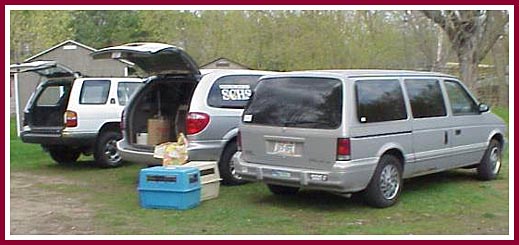 "We
cannot create a 'no kill' society until we shut down puppy mills, and implement
both aggressive spay/neuter programs to prevent unwanted animals and major
'responsible pet ownership' campaigns to educate the public. [Some no-kill
shelters] just turn away those they don't have room for...and others must come
in and clean up the mess." "We
cannot create a 'no kill' society until we shut down puppy mills, and implement
both aggressive spay/neuter programs to prevent unwanted animals and major
'responsible pet ownership' campaigns to educate the public. [Some no-kill
shelters] just turn away those they don't have room for...and others must come
in and clean up the mess."
On
24 April 2006, the task force of five highly-qualified volunteers arrived at
the Adams home. Team members included, in addition to Eilene Ribbens: Tammy
Harris, then-manager of the Sheboygan County Humane Society (SCHS); Dana Lubach, SCHS
Team Leader for Dogs and Certified Humane Officer; the SCHS vet/ Certified
Humane Officer; and a Vet Assistant/ Certified Humane Officer.
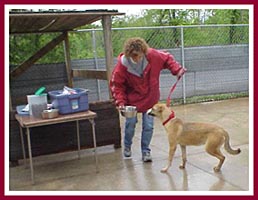 The
Washington County Humane
Society (WCHS) would later assist with follow-up visits and transportation
for several dogs to their facility for placement. Conspicuous by their
absence were representatives from the shelter from whom John Adams had acquired
16 dogs directly and two indirectly. The
Washington County Humane
Society (WCHS) would later assist with follow-up visits and transportation
for several dogs to their facility for placement. Conspicuous by their
absence were representatives from the shelter from whom John Adams had acquired
16 dogs directly and two indirectly.
Once
onsite, the Team had quite a surprise waiting for them: John had originally
admitted to having 20 - 30 dogs, then revised his estimate upward to
"around 60." Dog after dog after dog was brought out to be examined,
and the total number for the day was acutally 75! To their credit, the Adamses
knew every one of them by name.
Due
to the sheer number of animals, record keeping would be one of the Team's most
challenging tasks. All dogs must be tracked and monitored through the process
of completing the rescue. The Team set up an "assembly line" of
sorts, assigning each dog a number, and creating an intake form for each,
listing name, age, where the dog originally came from, obvious health problems,
and any other notes either observed or provided by the Adamses. The volunteer
photographer then snapped a picture of each dog before passing him/her and
his/her intake form along to the vet team for examination and shots.
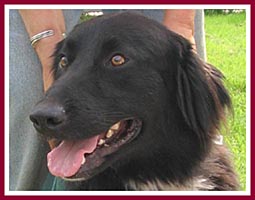 Only a few of the animals had been to
a vet in the past two years, and only a few had current rabies vaccines. THe
SCHS vet and his assistant examined each dog briefly, checked heart, lungs, and
teeth, drew blood for heartworm tests, and administered a rabies vaccine and a
distemper series to each dog who was old enough, then microchipped each. All
data -- vaccine types and dates, specific health comments, further treatment
needed, and microchip numbers-- were entered on the forms.
Only a few of the animals had been to
a vet in the past two years, and only a few had current rabies vaccines. THe
SCHS vet and his assistant examined each dog briefly, checked heart, lungs, and
teeth, drew blood for heartworm tests, and administered a rabies vaccine and a
distemper series to each dog who was old enough, then microchipped each. All
data -- vaccine types and dates, specific health comments, further treatment
needed, and microchip numbers-- were entered on the forms.
In general, the dogs were in good condition and were of average body weight and
condition. However, only 17 had been spayed or neutered, most were in need of
grooming and bathing, and several had dental issues. Miraculously, only ONE
tested positive for heartworm.
Dogs
ranged in age from 16-year-old Willard, who supervised the entire process, to a
litter of one month old pups, born onsite to one of the puppy mill
"rescues." Most were husky or husky mixes, but there were also a
variety of other breeds and mixes including beagle, pit bull, rottweiler,
border collie, yellow labrador retriever, and schipperke. (Please see our
Photo
Album for faces, ages, and breed heritage.)
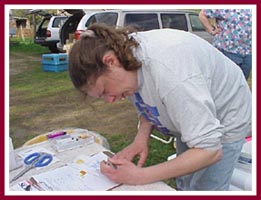 While some expected
pack order behavior was evident, no dog aggression issues were observed, and
individual dogs exhibited no noticeable injuries due to fighting. While some expected
pack order behavior was evident, no dog aggression issues were observed, and
individual dogs exhibited no noticeable injuries due to fighting.
However,
most of the adolescents were shy or frightened, and one or two were downright
terrified of handling. They had never worn collars nor had been leash walked.
Some of the adult dogs were also shy or submissive. Because of the sheer number
treated in one day, comprehensive physical or temperament evaluation of each
dog was impossible.
Due
to the cooperation of the Adamses, the lack of physical neglect, and their
obviously genuine affection for the dogs, the county animal control officer
decided that the couple should be allowed to choose 15 to keep, provided that
all dogs who remained on the property were up to date on their rabies
vaccinations and licenses. Attempting to prevent another "pup-ulation
explosion" in the future, the Wisconsin Puppy Mill Project picked up the
tab for spaying and neutering the seven unaltered dogs who would remain with
the Adamses, as well as any other vet work that the 15 needed.
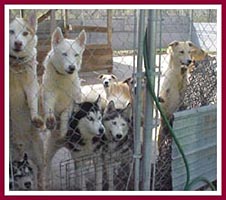 The total veterinary
cost for the 15 dogs remaining with the Adamses was $1,260. Altogether, an
estimated additional $8,500 was needed to take care of the one heartworm
treatment, nearly 60 spays / neuters, and other veterinary needs of the dogs
removed from the Adamses. We put out a call for donations to help toward these
bills -- see We Asked For Help for details.) The total veterinary
cost for the 15 dogs remaining with the Adamses was $1,260. Altogether, an
estimated additional $8,500 was needed to take care of the one heartworm
treatment, nearly 60 spays / neuters, and other veterinary needs of the dogs
removed from the Adamses. We put out a call for donations to help toward these
bills -- see We Asked For Help for details.)
Footnote:
After all of this, the county still granted the Adamses a kennel license in May
06 and told them that where they live, "they can have as many dogs as they
want."
Previous Page: The
Situation * Next Page: The
Follow-up
|

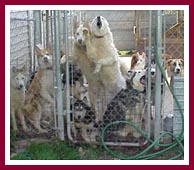


 Only a few of the animals had been to
a vet in the past two years, and only a few had current rabies vaccines. THe
SCHS vet and his assistant examined each dog briefly, checked heart, lungs, and
teeth, drew blood for heartworm tests, and administered a rabies vaccine and a
distemper series to each dog who was old enough, then microchipped each. All
data -- vaccine types and dates, specific health comments, further treatment
needed, and microchip numbers-- were entered on the forms.
Only a few of the animals had been to
a vet in the past two years, and only a few had current rabies vaccines. THe
SCHS vet and his assistant examined each dog briefly, checked heart, lungs, and
teeth, drew blood for heartworm tests, and administered a rabies vaccine and a
distemper series to each dog who was old enough, then microchipped each. All
data -- vaccine types and dates, specific health comments, further treatment
needed, and microchip numbers-- were entered on the forms. 
